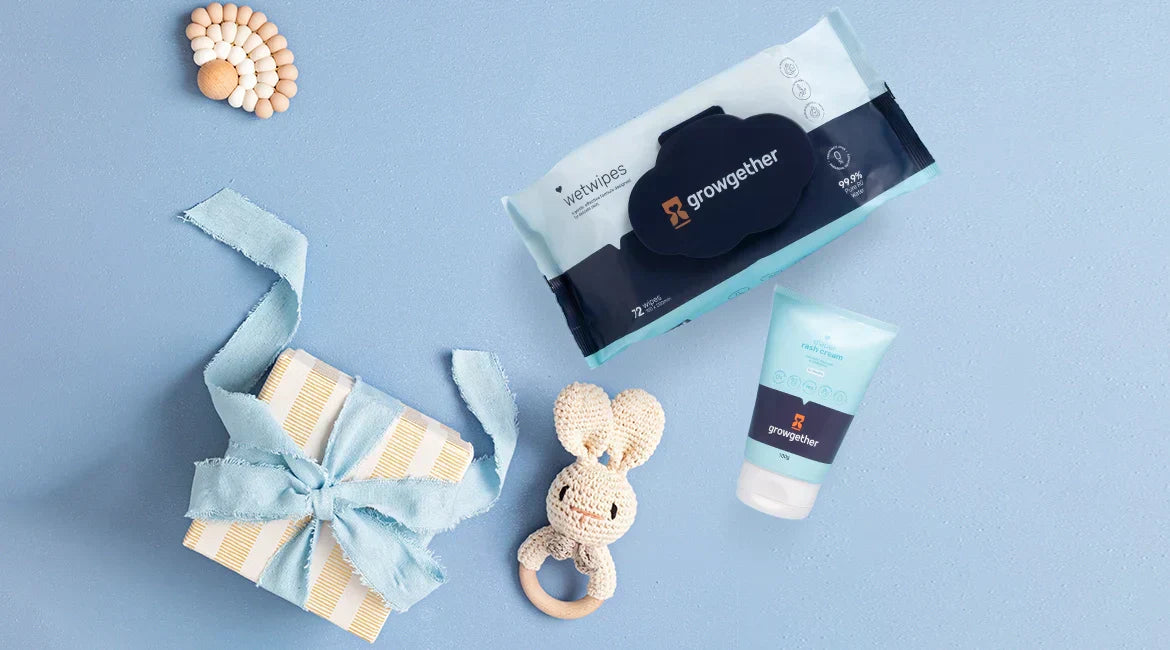Diaper Rash vs Heat Rash: Key Differences
Table of content
- What Is Diaper Rash?
- What Is Heat Rash?
- Diaper Rash vs Heat Rash: What’s the Difference?
- How to Deal with Diaper Rash
- How to Deal with Heat Rash
- When Should You Worry?
- A Real Example From a Parent
- Gentle Care with Growgether Diaper Rash Cream
- Common Questions About Diaper Rash vs Heat Rash in Babies
- Wrap-Up
Tired of Guessing What’s Bothering Your Baby?
Your baby’s skin looks red, they’re fussy, and you’re not sure what’s going on. Could it be a diaper rash or maybe heat rash? It’s a common worry, especially during hot days or the rainy season in India. Both rashes may seem similar at first glance, but they come from different causes and need different care.
This blog breaks it down in simple terms—how to spot the difference, treat both at home, and keep your baby comfortable.
What Is Diaper Rash?
What It Is
Diaper rash happens when your baby’s skin gets irritated from staying wet or dirty too long. It’s vone of the most common skin problems in babies.
Main Reasons It Happens
- Wearing the same diaper too long
- Friction from a tight diaper
- Reaction to baby wipes or soaps
- Bacterial or yeast infection
- Extra-sensitive baby skin
What It Looks Like
- Red, patchy skin in the diaper area
- Swollen or shiny skin
- Baby cries during diaper changes
- May also appear as rough or bumpy spots
What Is Heat Rash?
What It Is
Heat rash, often called “ghamori” in Hindi, shows up when sweat gets trapped under the skin. It’s more common in hot and humid weather.
Why It Happens
- Sweating in hot weather
- Wearing tight or synthetic clothes
- Staying in a warm room for too long
- Sweat glands getting blocked
What It Looks Like
- Tiny pink or red dots
- Often seen on the neck, back, or chest
- Itchy or gives a prickly feeling
- Skin doesn’t look swollen
Diaper Rash vs Heat Rash: What’s the Difference?
| Feature | Diaper Rash | Heat Rash |
|---|---|---|
| Where it appears | Diaper area (bottom, thighs) | Neck, back, chest, armpits |
| Main cause | Wetness and friction | Blocked sweat glands |
| Looks like | Red patches, may swell or bump | Small red dots |
| Pain/itch level | Can be painful when touched | Mild itching |
| Weather link | Any time, common during teething | Mostly during hot, humid days |
| Age group | Babies under 2 years | Babies and toddlers |
How to Deal with Diaper Rash
Do This:
- Change diapers more often
- Clean gently using cotton and water
- Use non-alcoholic and fragrance-free wet wipes
- Pat dry or air-dry before putting on a fresh diaper
- Use a mild, baby-safe diaper rash cream
- Give baby some diaper-free time daily
Avoid using powder; it may make things worse.
How to Deal with Heat Rash
Do This:
- Keep baby in a cool, airy place
- Dress them in soft, loose cotton clothes
- Avoid oil or thick creams
- Give lukewarm baths (neem leaves can help)
- Pat skin dry—never rub harshly.
Tip: Don’t apply heavy creams. Let the skin breathe.
When Should You Worry?
Call your doctor if:
- The rash doesn't improve in 2–3 days
- Skin has blisters, pus, or becomes raw
- Your baby develops a fever
- They seem more irritable than usual
A Real Example From a Parent
Neha from Jaipur saw red spots on her baby’s thighs after a long train trip. She thought it was a heat rash due to summer weather. But her doctor said it was a diaper rash caused by long hours in the same diaper. With some fresh air time and the right cream, her baby’s skin got better in just a few days.
Gentle Care with Growgether Diaper Rash Cream
If diaper rash is the problem, you can buy our best diaper rash cream for your baby. It’s made for daily use, even on newborns.

What’s Inside:
- Zinc Oxide – Soothes and forms a soft barrier
- Squalane – Keeps skin moist and smooth
- Chamomile – Calms irritated skin
- Coconut Oil – Naturally fights germs and dryness
Why Parents Choose It:
- Light, non-sticky formula
- Safe to use from birth
- Safe, clean and hypoallergenic
- Dermatologist-tested
Free shipping on orders over ₹499
Use code WOW for 10% off your first order.
Common Questions About Diaper Rash vs Heat Rash in Babies
Q1. How can I tell if it’s a diaper rash or heat rash on my baby?
Diaper rash usually appears in the diaper area with red, swollen patches, while heat rash shows up as tiny red dots on the neck, chest, or back—especially in hot weather.
Q2. Can diaper rash and heat rash happen at the same time?
Yes, it’s possible. Your baby can have a diaper rash from wetness and a heat rash from sweat in other body areas, especially during summer.
Q3. What cream works best for diaper rash but not heat rash?
Use a zinc oxide-based diaper rash cream for diaper rash only. For heat rash, avoid creams—keep the skin cool, dry, and uncovered to heal naturally.
Q4. How long does it take for diaper rash or heat rash to go away?
Mild diaper rash improves in 2–3 days with proper care; heat rash usually clears within a day or two when skin stays cool and dry.
Q5. Can I use baby powder for heat rash or diaper rash?
It’s better to avoid powders, as they can clog sweat glands in heat rash and worsen diaper rash by trapping moisture. Stick to creams and airflow.
Wrap-Up
Diaper rash and heat rash are both common, but they need different fixes. Diaper rash needs better hygiene and a soothing cream. Heat rash needs fresh air, cotton clothes, and cooler spaces. Keep a close eye, act early, and your baby will be back to smiling soon. And if diaper rash sticks around, give Growgether’s cream a try—it's made for these moments.





